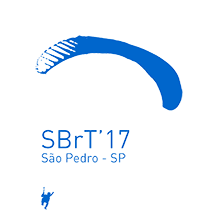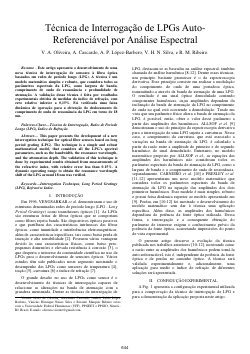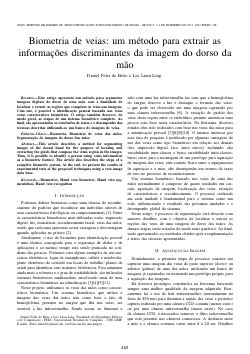
XXXV Simpósio Brasileiro de Telecomunicações e Processamento de Sinais

Performance Analysis of Energy Constrained Cognitive Full-Duplex Generalized Network Coding Scheme
Samuel B. Mafra, Evelio M. G. Fernandez, Samuel Montejo-S´anchez, Hebert Douglas Pereira
DOI: 10.14209/sbrt.2017.223
Keywords: Energy Harvesting Cognitive Radio Network Coding Full-Duplex
Abstract
We evaluate the performance of an energy con- strained cognitive full-duplex network coding based scheme. The secondary cooperative network is composed of two energy- constrained full-duplex users that cooperate to transmit their independent information to a common destination. The secondary users do not have sources of energy and they harvest energy from the signals transmitted by the primary user. We show through theoretical and numerical results that the proposed energy harvesting cognitive full-duplex scheme has the best performance in terms of outage probability, when compared with energy constrained half-duplex network coding scheme as well as to the direct non-cooperative transmission.Download

Técnica de Interrogação de LPGs Auto- Referenciável por Análise Espectral
V. A. Oliveira, A. Cascardo, A. P. López-Barbero, V. H. N. Silva, R. M. Ribeiro.
DOI: 10.14209/sbrt.2017.230
Keywords: Interrogation Technique Long Period Gratings (LPG) Refractive Index
Abstract
This paper presents the development of a new interrogation technique for optical fiber sensors based on long period grating (LPG). The technique is a simple and robust mathematical model, that considers all the LPG’s spectral parameters, such as the bandwidth, the resonance wavelength, and the attenuation depth. The validation of this technique is done by experimental results obtained from measurements of the refractive index, with relative error less than 0.15%. A dynamic operating range to obtain the resonance wavelength shift of the LPG around 18 nm was verified.Download

Biometria de veias: um método para extrair as informações discriminantes da imagem do dorso da mão
Daniel Felix de Brito, Lee Luan Ling
DOI: 10.14209/sbrt.2017.232
Keywords: Biometrics Hand vein biometric Hand vein seg- mentation Hand vein recognition
Abstract
This article describes a method for segmenting images of the dorsal hand for the purpose of locating and extracting the pixels that compose the veins region in the images. Thus, it is possible to identify a person using veins information as a biometric feature. The article also describes the steps of a complete biometric system. At the end, we present the results of experimental tests of the proposed techniques using a vein image data base.Download

IoT Network Management: Content and Analysis
Jonathan de Carvalho Silva, Joel J. P. C. Rodrigues, Mario Lemes Proenc¸a Jr
DOI: 10.14209/sbrt.2017.233
Keywords: Network Management Device Management Internet of Things IoT
Abstract
Currently, physical objects are integrated and con- nected in the networks to provide services for people perform- ing the well-known Internet of Things (IoT) paradigm. IoT environments are characterized by a high degree of devices heterogeneity and network protocols, where each object may have different processing capabilities or different communication patterns, making a lack of standardization in IoT. This demands a dynamic and context-aware configuration management system. Currently, in the literature, there are no management platforms that address IoT issues, such as scalability, heterogeneity, and context-aware. For this purpose, the study elaborates on available policies and solutions for network management and devices in IoT, highlighting and discussing the features of each studied project, identifying open research issues on the topic.Download

Utilizando a segunda camada do modo fantasma para aprimoramento de aplicações G.fast
M. M. M. Freitas, D. D. Souza, B. P. T. Sousa, D. A. Gomes, C. S. Sales, R. M. Rodrigues, J. C. W. A. Costa
DOI: 10.14209/sbrt.2017.237
Keywords: Phantom mode second phantom layer aggregate rate vectoring EVM
Abstract
Phantom mode has been proposed to improve G.fast applications. However, the most of the phantom mode systems deploy the first phantom layer only. Nevertheless, this work analyses the feasibility of a system, which deploys an additional phantom mode level, called second phantom layer. The entire system, first and second layers and differential modes, can reach bit rates up to 15 Gbps in lengths up to 30 m, when vectoring is applied. The achieved levels of EVMs are according the 3GPP standard even under Ethernet interfering influence.Download

Digital TV signal evaluation for functional tests
Rogério Caetano, Eddie B. de Lima Filho, Carmina Porto
DOI: 10.14209/sbrt.2017.235
Keywords: Digital television signal testing verification pro- cess real time monitoring
Abstract
Verification process in digital television (DTV) pro- duction often includes a tuning and decoding check, which ensure that assembled devices are capable to reproduce audio and video. Poor test signals conditions, however, may cause device rejection, leading to losses of time and money for the manufacturer. This work proposes a real time DTV test signal monitoring and evaluation that assess signal conditions during tuning tests aiming to report if the associated check must be rerun. Tests, in a real manufacturing environment, showed that the proposed methodology is effective and revealed that only less than 40% of the rejected devices presented nonconformances.Download

Blind Equalization Based on Complexity Measures: Is It Feasible?
Patrick F. Coutinho, Diogo C. Soriano, Filipe I. Fazanaro, Ricardo Suyama, Romis Attux
DOI: 10.14209/sbrt.2017.236
Keywords: Algorithmic complexity Blind channel equaliza- tion Chaotic signal processing Recurrence plot
Abstract
This work investigates an alternative approach to the problem of blind equalization. The approach is based on complexity measures and is inspired by preceding successful application of the same framework to the problem of blind source separation. We draw the relationship between algorithmic com- plexity, a measure for randomness within the area of algorithmic information theory, and recurrence quantification analysis, a tool for recurrent structure analysis of dynamical data. The evaluation of the hypotheses is carried out in the context of chaotic signals. The results show that such approach is effective under some circumstances (minimum-phase or stable and invertible channel).Download

Desenvolvimento de antenas impressas em substrato de Fenolite
Daniel Aparecido Pires, Henrique José da Silva
DOI: 10.14209/sbrt.2017.238
Keywords: Antenas impressas antenas microlinha agregado de antenas constante dielétrica largura de banda.
Abstract
Este trabalho apresenta um estudo sobre antenas impressas do tipo microstrip ou microlinha, construídas sobre um substrato convencional de Fenolite, também muito usado em eletrônica. As antenas são projetadas para operar a 2,4 GHz. Mostra-se um projeto evolutivo de um elemento radiante para um agregado de dois elementos radiantes. Em primeiro lugar, projeta-se uma antena de configuração retangular com o intuito de determinar e validar, através de medida e correção da simulação, o valor da constante dielétrica para 2,4GHz. Seguidamente projeta-se e simula-se a estrutura de adaptação de impedâncias para um agregado de dois elementos radiantes. Os dois elementos tem dimensões ligeiramente diferentes, para que se obtenha uma maior largura de banda de frequência de trabalho. Com essa técnica e numa primeira fase, verifica-se um aumento de largura de banda de 3MHz para 32MHz.Download

Avaliação de desempenho de wavelet shrinkage pela esparsidade dos coeficientes
Vinícius Ávila da Silva, Evandro Ottoni Teatini Salles
DOI: 10.14209/sbrt.2017.239
Keywords: Denoising Wavelet Shrinkage Sparsity
Abstract
The wavelet shrinkage approach has been considered a method of low computational cost and reasonable performance in signal denoising. However, this method is not entirely adaptive, because of its dependence on parameters such as the wavelet function and scale. This paper aims to evaluate the relation between the performance of the method and the sparsity of the wavelet coefficients. It was observed that the signal SNR increase, in db, relies greatly on the aforementioned parameters, and that the sparsity can be a tool to adapt the parameters to each sample set.Download

Utilização da técnica MFCC em conjunto com os parâmetros extraídos do sinal glotal para melhorar o desempenho de um sistema de verificação de locutor
Filipe Moreira da Silveira, Carla Florentino Schueler, Edson Cataldo
DOI: 10.14209/sbrt.2017.234
Keywords: Speaker verification MFCC Glottal signal HMM
Abstract
This article presents the development of a text dependent speaker verification algorithm, which alias the Mel Frequency Cepstrum Coeficients with parameters calculated from the glottal signal using Hidden Markov Models to identify the stochastic pattern of these measurements. The glottal signal is generated when the air flow passes through the vocal chord, and is obtained in this work by inverse filtering.Download